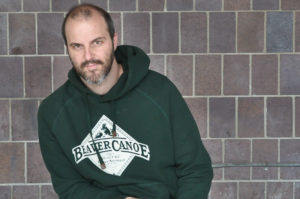Audio report by Juanita Bawagan
Electric Fields, an annual electronic arts festival, took audiences through uncharted territory — from a chilly sound dome to the depths of hell.
The festival, which ran Oct. 10-14 across Ottawa and Gatineau, centred on the theme of sound and space. Along with performances, this year featured an inaugural panel series.
The concept for the panels stemmed in part from artistic director Ryan Stec’s learning experiences at Carleton as a second-year master’s of architecture student.

“Within school there’s a different kind of experience, there’s a formal kind of education but how do you bring some ideas into it,” he said.
“In the festival there’s this freedom and creativity around the ability to mash up ideas and to bring together different people . . . and to push creative boundaries.”
Going to performances and attending talks created a more “whole” learning experience, Stec said.
But this is no ordinary classroom.
A 20-foot screen towered atop the altar at St. Brigid’s Art Centre Oct. 12. People filled the pews of the former church as digital flames licked the screen and droning waves flooded out from the speakers. The comparisons to satanic rituals are hardly subtle as “Lucifer,” the installation’s title flashes its fiery letters across the screen.
The choice of a church for Lucifer was tongue-in-cheek, Stec admitted. He said it not only immersed audiences in a sound space but also changed the meaning through the cultural space of the church.
Architecture was a primary focus at the festival. Talks included several architects and a graduate symposium in Carleton’s architecture building featuring professors and students.
The talks included many artists who work with sound and space as well, like Carleton music professor Jesse Stewart. Stewart kicked off the talks at the first panel “How does sound influence space,” with digital grandfather Barry Blesser, sound artist Gordon Monahan and architecture graduate Matthew Edwards.
Stewart recalled a number of the alternative spaces where he’s performed, including a cave.
It had rained for 18 hours and the water had seeped through the limestone and formed a small stream, he said. To respond to this, he played stone instruments and used a waterphone, which has prongs attached to a cavity filled with water.
Things got even eerier, he said, when the bats woke up around 10 p.m. and could be heard “chattering” on the recording.
Stewart chalked one more alternative space to his list at the festival. He played in a geodesic dome — a canvas dome structured out of metal beams.
No matter what space Stewart plays in, there’s a common thread.
“I’m responding to the setting,” he said.
Stec said this applies equally to what he wants to do with architecture and in his artistic work.
Stec has led a career as a VJ, sound artist and the director of the electronic art organization Artengine that runs Electric Fields. Still, he said he went back to school to expand his horizons.
“Maybe architecture might come out of my life but it’s also about thinking about a different model for producing,” Stec said.
“[It’s about] stepping outside and bringing those two worlds together.”





